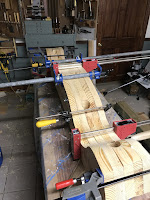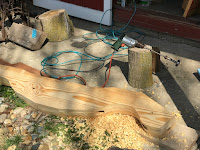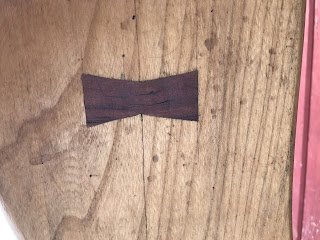"We used to figure that every team new to a cart would probably have one runaway" - Dick Roosenberg
Helping with Oxen Basics at Tillers International for years and then teaching the class a few times, I've been lucky to watch dozens of oxen start their careers. One of the big milestones is when they pull a cart for the first time. It can be quite a rodeo, but it doesn't have to be.
Reasons FOR a runaway:
-A cart is "new" to the team.
-Carts make funny noises, dissimilar to chains and dragged objects.
-Carts have a tongue that weighs down the yoke, a new sensation.
-Carts are a visual that is larger and higher than a dragged object, making them appear to be a larger predator.
-Carts get louder as they move faster.
-Carts "push" the animal on the inside of any turn with the tongue.
-Carts "push" the yoke when the team tries to stop them.
-Adding any two of these factors is not simple addition. It's more like exponential growth for a feedback loop.
Dealing with any and all of these things is pretty similar to the approach I described for an adult team here, but with some minor changes, so let's use the original list to talk through ways to avoid a runaway.
Ways to AVOID a runaway:
-A cart is "new" to the team.
Everything is new to calves. They are visitors to the "Everything Else
in the Whole Wide World Museum." Let the team see and smell the cart. Make time with new things to let them see you acting calmly while they explore.-Carts make funny noises, dissimilar to chains and dragged objects. Everything following calves can be seen as a predator. Start by having a partner pull the cart away from the team. If you're by yourself, tie them and pull it "parallel" to the team. Cars travelling along the road don't spook animals as long as they are moving in a predictable way. Same with 'real' predators on the prairie. Make the cart replicate that so the noise is created in a 'safe' way. We trained a pair of Jerseys that followed the cart and would catch it and sniff and lick it while walking along. Not surprisingly, they didn't spook when hooked to the cart.
-Carts have a tongue that weighs down the yoke, a new sensation. Assume that all animals believe that any new thing is permanent. They fight a halter since they believe that it's new and will always be there. Same with anything. Reset that expectation with anything new. Put it on, take it off. Repeat. By the third time the tongue is in the ring on the yoke, it's usually old hat.
-Carts are a visual that is larger and higher than a dragged object, making them appear to be a larger predator.
Ok, there's no solution to this, only an opportunity. Forever, the team will need to stand while the objects behind them change size, shape, and sound. Watch a sound team like Kevin Cunningham's stand for a tractor to load manure into the "ox box," and you'll quickly see why it's an opportunity to build soundness and not an obstacle to success. -Carts get louder as they move faster. Step once. Stop. Step. Stop. Step. Stop. Step. Stop. Step. Stop. Step. Stop. Step. Stop. Are you bored yet? Yeah, they are, too. Problem solved.
-Carts "push" the animal on the inside of any turn with the tongue. Again, an opportunity, not a problem. Working animals need to sidestep. Practice, rather than genetics, makes that happen.
-Carts "push" the yoke when the team tries to stop them. We probably should have started with this, but start out going up a gentle rise. When they stop, the cart stops, rather than pushing up against the team with momentum. If you need to unhook and walk the cart back down a few times, imagine yourself as a 'good' trainer rather than a 'slow' trainer.
-Adding any two of these factors is not simple addition. It's more like exponential growth for a feedback loop. Yes, a lead rope is probably a good idea at first. Yes, the odds are now ever in your favor.
Yes, you can do all of these things well and have a runaway. A panicked runaway with calves on a cart is something you won't forget. But the team will. Once. Maybe twice. Learning that they can simply run with a cart and get away from you? That's another matter. And, as we say, a tale for another day.




































